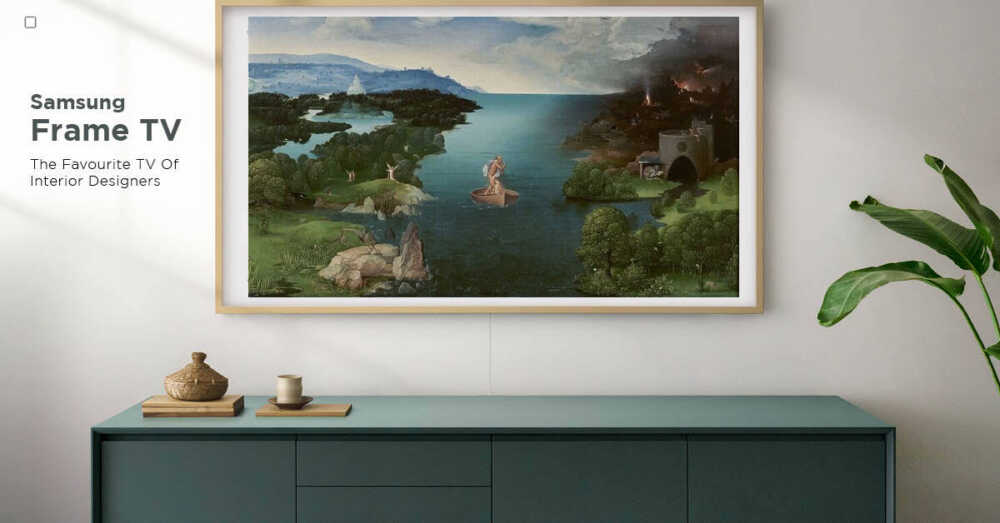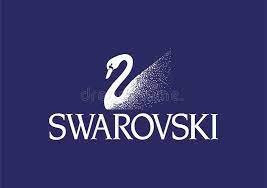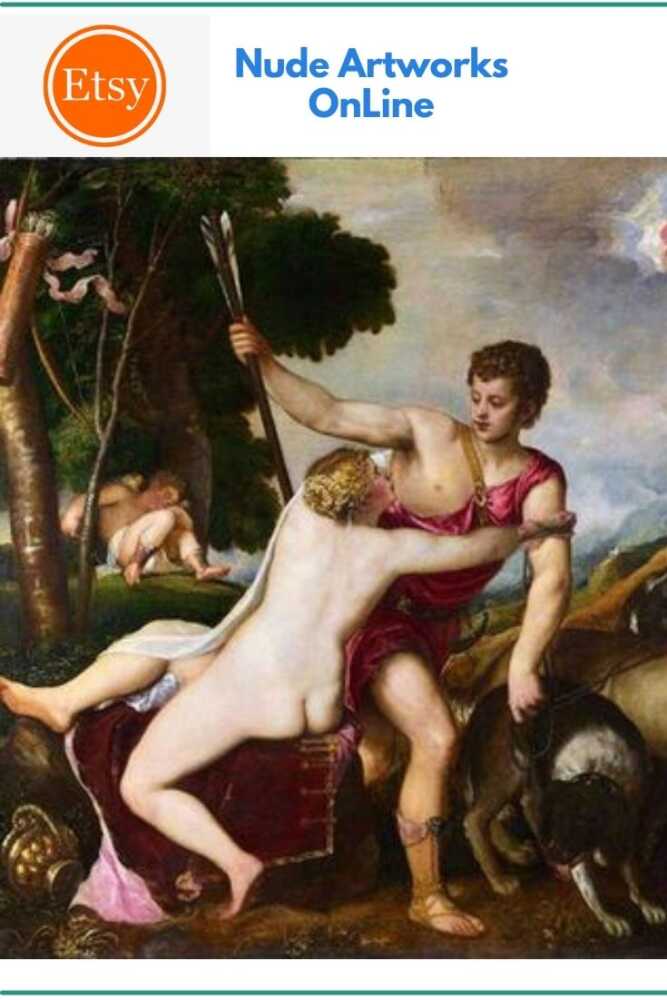
History of Nude Painting in Art Renaissance Era – 15th to 17th centuries
Rubens + Da Vinci + Titian + Tintoretto + Giorgione + Botticelli + Van Loo + Correggio + Jacob Jordaens + Lemoyne. +
What’s the renaissance?
The Renaissance was a fervent period of European cultural, artistic, political and economic “rebirth” following the Middle Ages. Generally described as taking place from the 15th century to the 17th century, the Renaissance promoted the rediscovery of classical philosophy, literature and art. The Renaissance period cultivated a new change in art, knowledge, and culture. It changed the way the citizens thought, with first the rediscovery of classical philosophy, literature, and art, as well as the new discoveries in travel, invention, and style . Nudists art, nudity painting, nude in paint, nude painters, nudity in painting, they are similar terms.
What was nude painting like in the Renaissance?
In the Renaissance, Nude art returns to the past towards the search for ancient art from Rome and Greece, bringing a huge amount of architectural ruins and sculptures that become canonical models, artists will follow from now on. This recovery begins in Florence in the first decades of the 15th century, spreading in a very short time throughout Rome throughout northern Italy.
Still in the Middle Ages in the year 1300 approximately some sculptors made images that they took directly from classical works with the old model, but they are only small exceptions to the medieval rule that reigned at that time is in the second decade of the following century when so definitively the new classic concept is consolidated.
The pioneers of the Renaissance nude are for example the painter Masaccio and the sculptor Donatello, who manage to impose classicism thanks to their particular talent with purely classical motifs in Christian contexts without contradicting the basic feelings that the work should convey.
Tintoretto
Renaissance Nude Paintings
Tintoretto Print on demand in Etsy
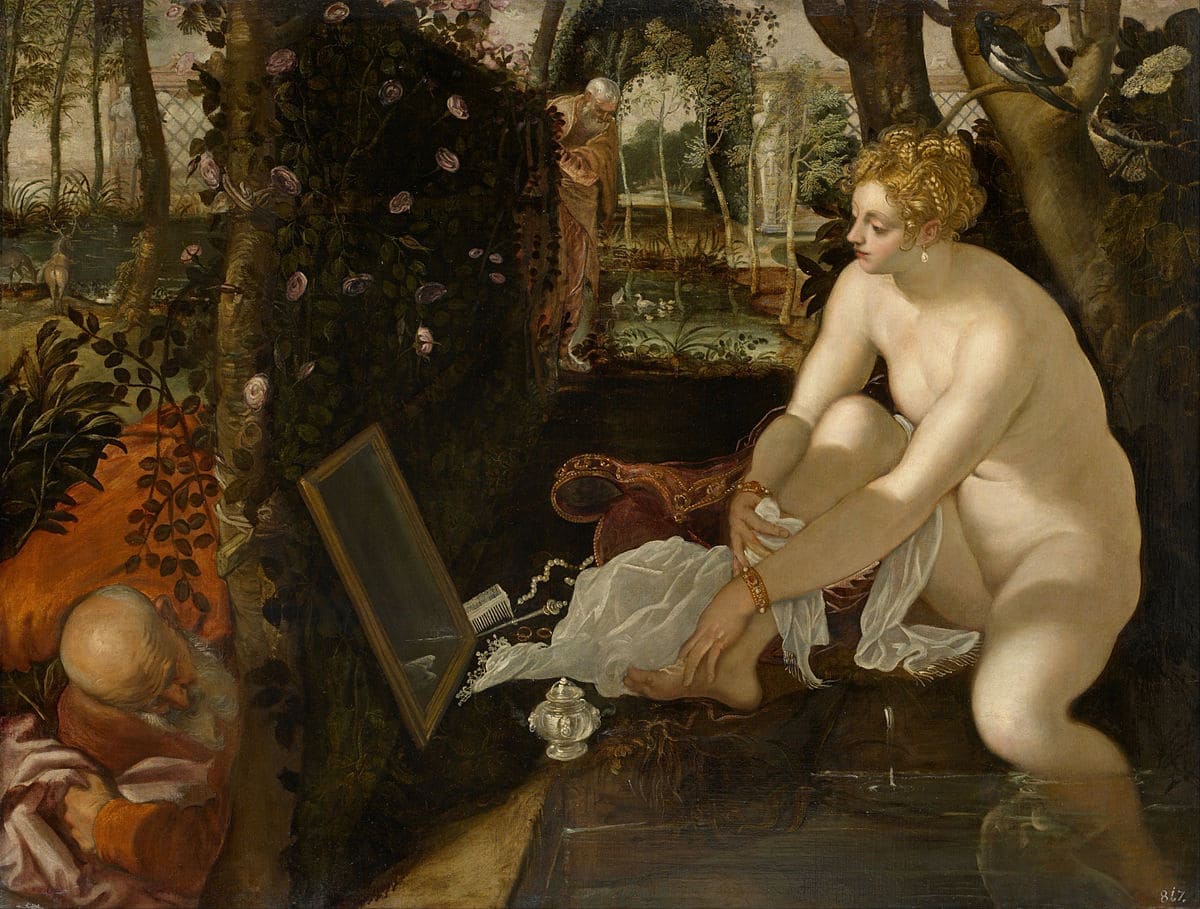
Tintoretto followed Titian and although more devoted to religious themes, he also cultivated mythology and the nude. His chromatic range is warm and exalted, reflecting a certain restlessness by means of foreshortenings and anatomical distortion close to mannerism, as in Venus, Vulcano and Mars or Susana and the old men. He prefers Paint male nudes, following Michelangelo’s heroic canon
Tintoretto Print on demand in Etsy
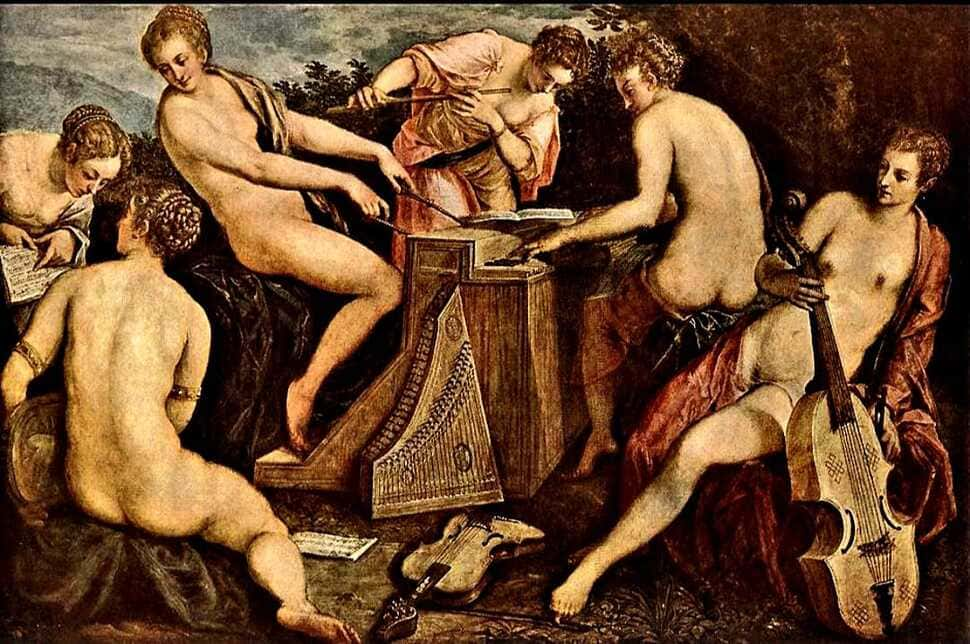
Jacopo Tintoretto (1519-94) – The Muses
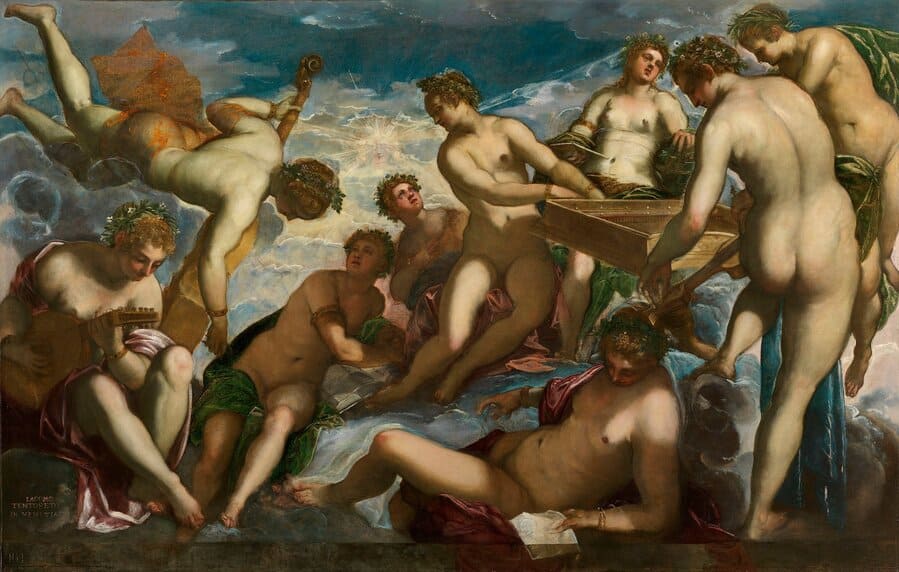
The Quattrocento – Renaissance Nude Paintings
The Nude Painting in Art Renaissance is adopting various sources according to the tastes of the courts for which artists work. The courtly character of much of Renaissance production conditions the interpretation of the classical nude. Values are beginning to be adopted in these Italian courts with a taste for Platonic philosophy, Christian symbolism, mixed with pagan ones. This is directly reflected in the pictorial compositions bringing together numerous nudes inspired by antiquity and which also take on many symbolic and allegorical meanings.

Sandro Botticelli
The Birth of Venus (1484)
Tempera on canvas, 184.5 x 285.5 cm, Uffizi, Florence
Renaissance Nude Portraits
Who was Sandro Botticelli?
Alessandro di Mariano di Vanni Filipepi, nicknamed Sandro Botticelli – Florence, 1445-1510 – , was the favorite painter of the Court of Lorenzo de’ Medici, at a time of fundamental importance for the flourishing of the arts in Florence in the fifteenth century, known like the Florentine Golden Age.
What are the Frescoes of Sandro Botticelli?
In 1481 he was called to Rome to work on the decoration of the Sistine Chapel in the Vatican, where he painted the frescoes The Trials of Moses, The Punishment of the Rebels, and The Temptation of Christ. In the 1490s, after the expulsion of the Medici from Florence, and when the Dominican monk Girolamo Savonarola preached austerity and reform, he suffered a religious crisis, although he did not leave the city.
Botticelli Art Print on Demand on Etsy
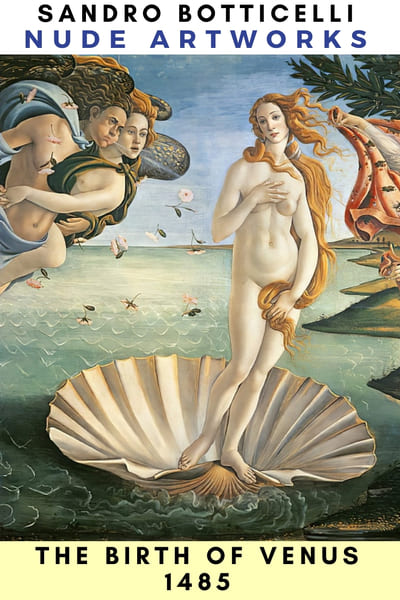
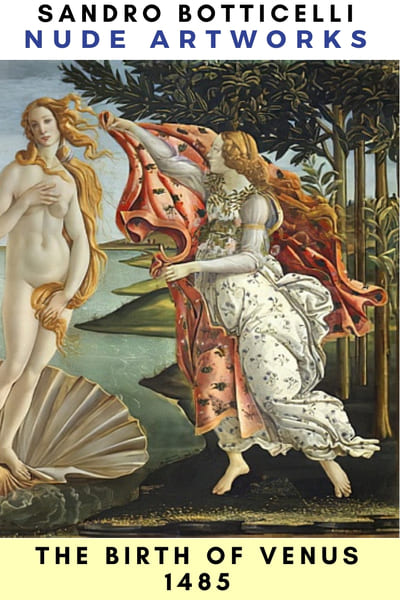
Sandro Botticelli that his own works?
In 1497 Botticelli burned part of his works alluding to mythology, with the exception of The Birth of Venus, which was saved from the flames of the Bonfire of the Vanities in 1497. In this year, followers of the monk Girolamo Savonarola collected and burned in public thousands of objects considered sinful.
ETSY Painting Prints

Raphael
on Amazon
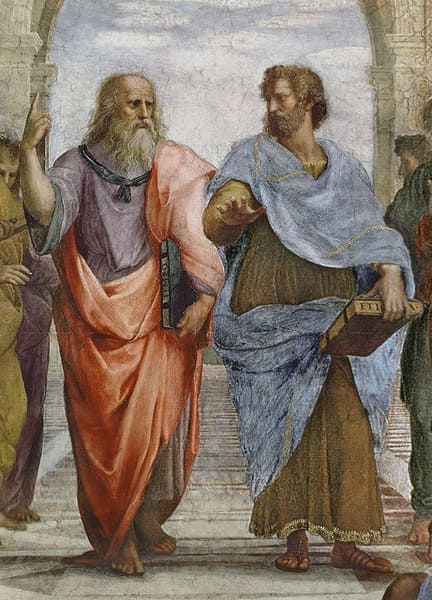
Botticelli
on Amazon
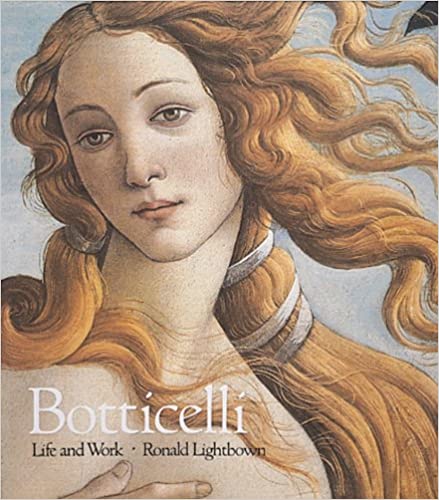
Leonardo da Vinci
on Amazon
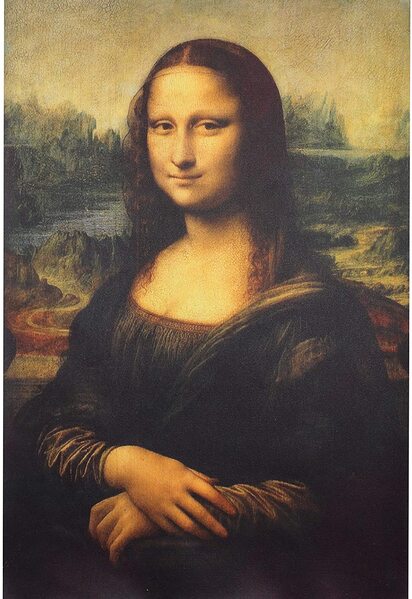
Nudity in Renaissance: Splendor of the Nude
In the final stage of the Renaissance, he passed in a splendid way to Baroque Art which is not exclusively an Italian art. Italy, is the main reference point, the classicist values spread throughout Europe and the great masters come from both the North and the South.
Titian
Venus recreating herself with Love and Music
Renaissance nude paintings
Titian Print Art on demand on ETSY
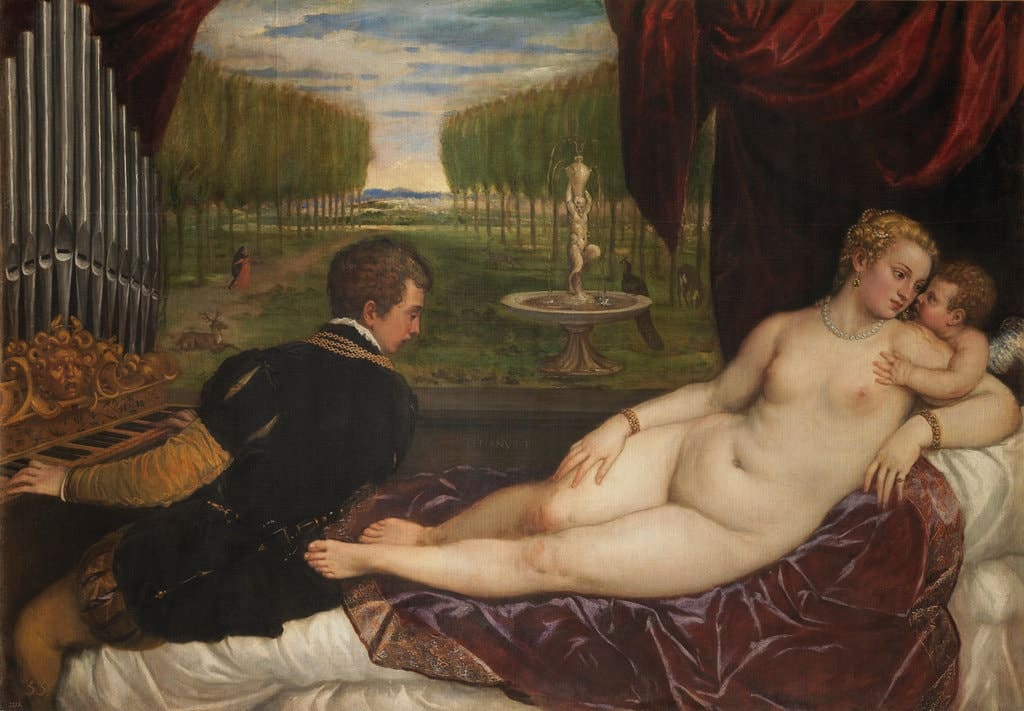
In the Baroque, the classical nude reaches the maximum degree of expressiveness, it is the Venetian artists of the 16th century who mark the climax of the full Renaissance. At this maximum point we can name great artists from Venice such as Titian, Veronese and Tintoretto, it is the three of them who manage to express the main premises of the classical nude, achieving it as a harmonic unit. From the extraction of form rather than from the scrupulous aberration of nature.
Titian Print Art on demand on ETSY
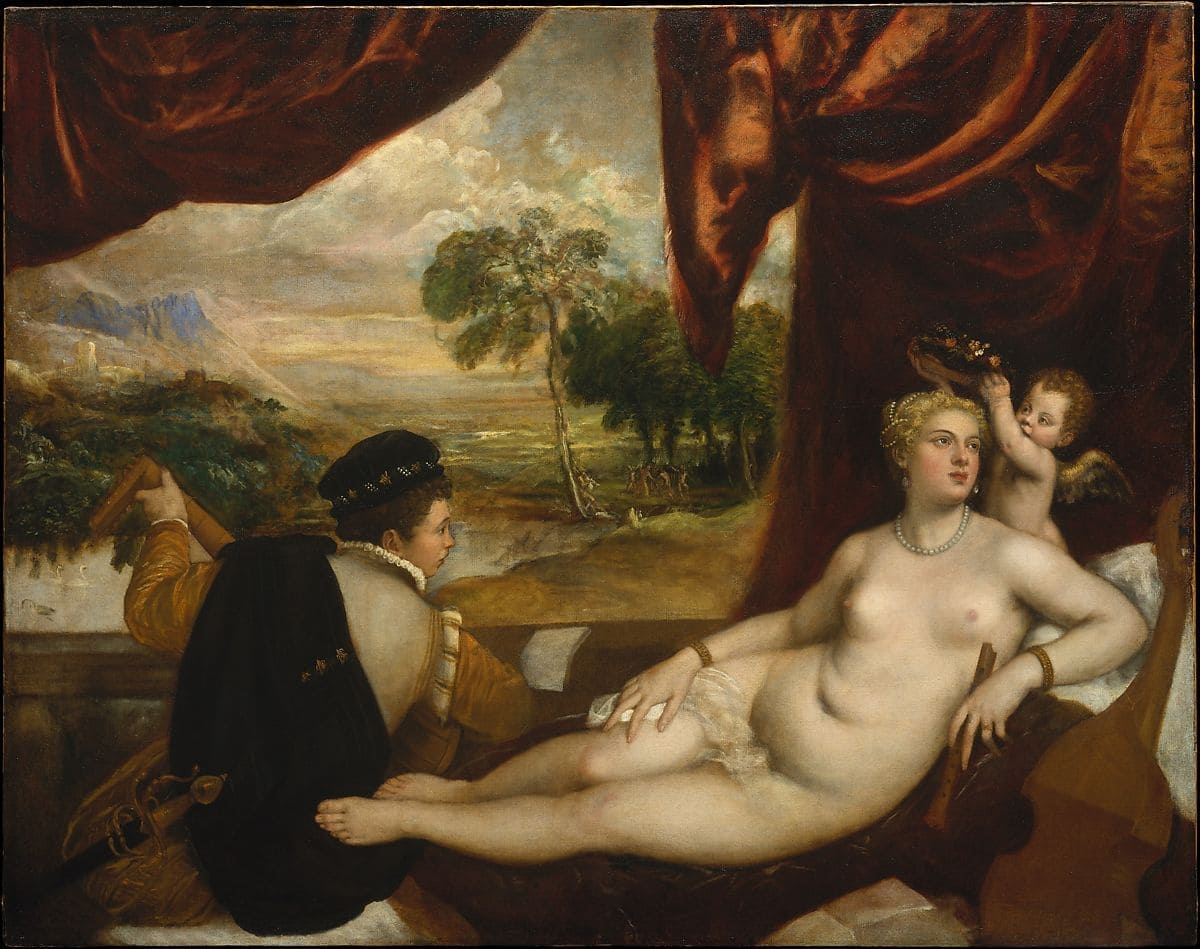
Venus, the goddess of love, interrupts her music making to be crowned with a wreath of flowers by Cupid. An admiring, well dressed youth playing the lute-the quintessential instrument for love madrigals-gazes at her raptly. In the background nymphs and satyrs dance to the music of a shepherd. Titian painted this amatory theme multiple times. This one was left unfinished, except for the landscape background, which is fully painted by the artist. Once believed to allude to contemporary debates concerning “seeing” versus “hearing” as the primary means for perceiving beauty, these pictures seem mainly to celebrate sensual pleasures.
Venus of Urbino
Titian
Titian Print Art on demand on ETSY
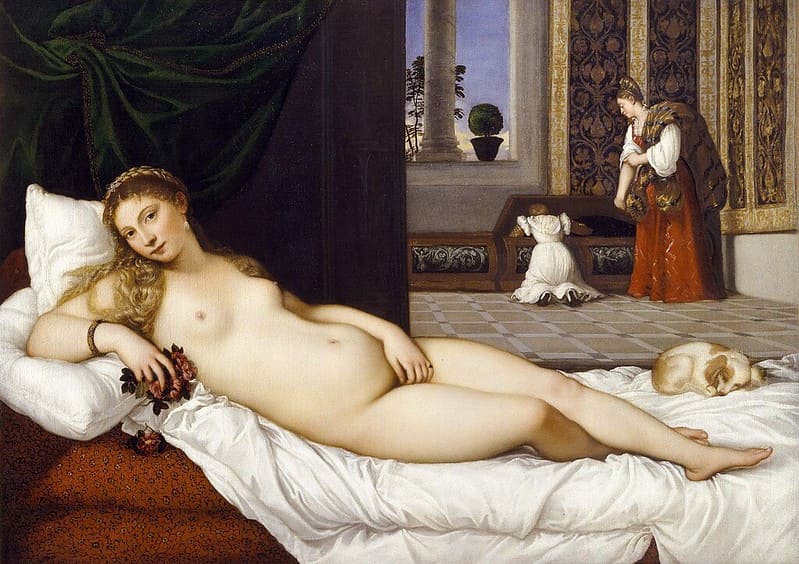
In 1631 this painting was in the Medici collection; since 1736 it has been in the Galleria degli Uffizi (Florence).
The painting, whose client was Guidobaldo II della Rovere, then the son of the Duke of Urbino, represents a half-naked young woman reclining on a luxurious bed inside a Venetian mansion.
In the background there is a large window through which slight reflections of the lagoon enter and the sky can be seen behind a tree; Next to the window there is a girl and the maid enigmatically with her back turned, rummaging through a cassone or wedding chest; the chest seems to evoke the myth of Pandora’s box.
At the feet of the naked young woman a puppy sleeps; the presence of the dog is a sign that the one represented is not a goddess, but a real woman, although it is not known exactly who she is. Something else: the dog, a typical allegory of fidelity, appears here asleep.
The harmonious nudes of Raphael – Raffaello Sanzio would be the obligatory starting point for all classicist artists and painters.
Renaissance Nudes: Raffaello Sanzio
The three graces, 1504-1505.
Oil on wood. 17 x 17 cm. Condé Museum, Chantilly
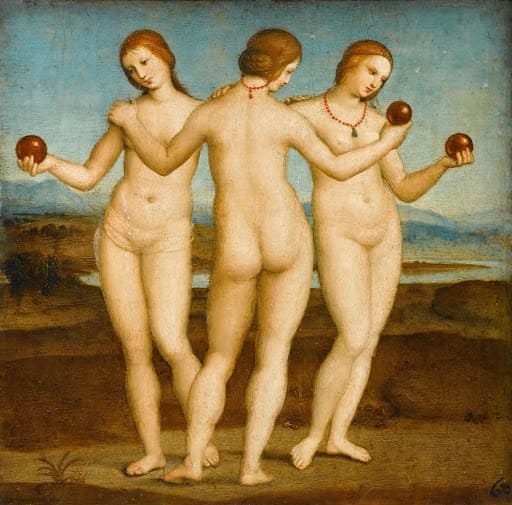
The theme of the Three Graces comes from Greco-Roman antiquity.
Her names in ancient Greece were:
Aglaya (Beauty), Euphrosine (Joy) and Talia (Abundance) Her names in ancient Rome were:
Cástitas (Chastity), Voluptas (Voluptuousness) and Pulchritudo (Beauty)
In their plastic representation they are identified as companions of Venus, and then, as qualities of Love. In this way, they appear as three female nudes, since Venus or Aphrodite is the goddess of love and sex, and one of her attributes for recognizing it is nudity.
Rafael’s work is perfectly harmonious: from the composition, the sinuosity of the postures and their serenity, the light and the color. It is a good example to understand why it had so much influence on later art, reaching it to spread through academic circles for several centuries. There is no Time in this image, because we are before divine figures, for whom time and the future have no meaning.
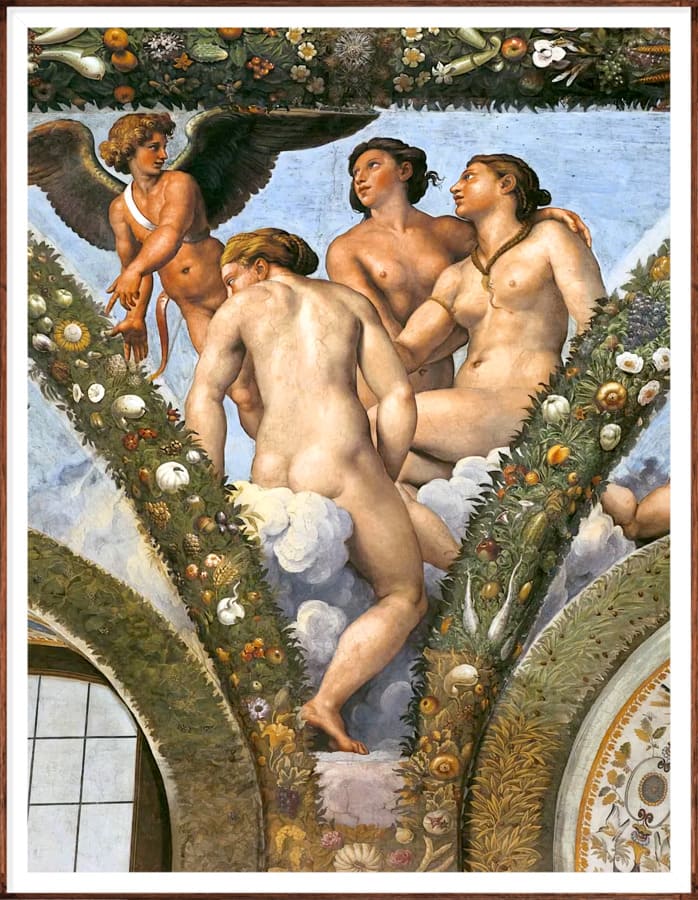
Cupid and the Three Graces
Wonderful fresco of the young Raphael in full golden age.
Agostino Chigi was the Pope’s treasurer, so his palace should not be of a lower category than the Vatican Rooms. Chigi decided to call on the artist who had painted them, Raphael Sanzio, to design the decoration of the gallery (loggia) on the ground floor of the Villa Farnesina.
There you can see, among masterpieces such as “The Triumph of Galatea” or “The Banquet of the Gods”, frescoes of numerous mythological scenes that are located between the pendentives. In this case, the Three Graces (Aglaya, Talía and Eufrosina) are represented, the goddesses of beauty, enchantment and joy, who were always naked.
Daughters of the love between Cupid and Psyche, here they are seen with their winged father and for once in the history of art, they are not dancing. Raphael was the greatest painter of the cinquecento, and he painted guided by his taste for the Greco-Roman, which, as we all know, considered nudity to be beauty.
Rafael did not do many nude works in his artistic career. When he decorated the palace, Rafael spent more time in Las prostibuos than between brushes. In fact, it is believed that the artist died in a brothel. One night he went to celebrate an errand at the Cavern of the Merry Maidens, where he had “acquaintance with several of them from evening, night, and early morning, and returned home with a fever and greatly diminished.” He died at the age of 37.
Museum: Villa Farnesina, Rome (Italy)
Technique: Cool
Loggia of Cupid and Psyche,
Villa Farnesina, Rome
Nude in Art Renaissance: The Baroque
The Baroque takes the Renaissance values to the maximum, including to the extreme of their possibilities. The purpose that had motivated the highest creations was the climax of the Renaissance. This baroque movement spans the end of the 16th century and the middle of the 17th century and is an art whose presence is imposed throughout all of Europe. Italy continues to occupy the center of artistic creation but local and national schools develop their own independent forms, however, they share many common characteristics giving a stylistic unity to the art created throughout this era.
Danae receiving the golden shower, painting painted in the 16th century by Titian, exhibited in the Prado Museum.
Leonardo Da Vinci
Leda and the Swan
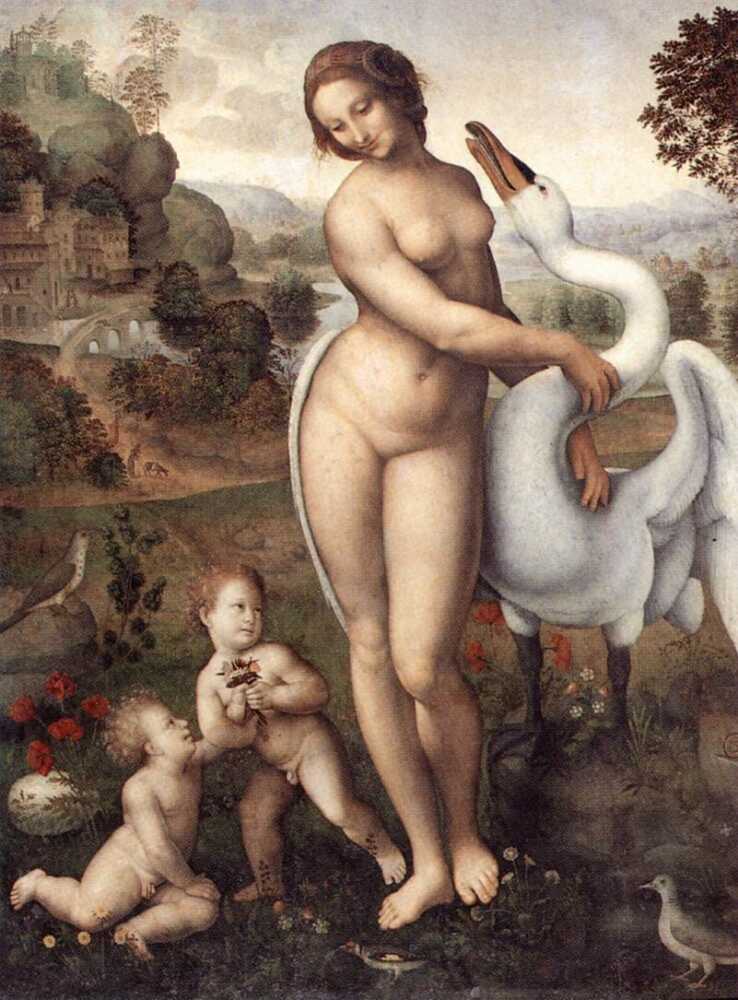
Baroque became a common style throughout Europe and at this time artists moved freely from one country to another. In this way they have access to news and models that must continue to continue two great artistic traditions. We are referring to the Nordic, the Southern, the Gothic and the Classical. Northern painters tend to be nude more attached to objective facts that shape the human form.
Southern artists give a more abstract version of the nude looking for simple and valid forms in themselves. These differences still persist and are noticeable in many figurative works of contemporary art.

Related Post
- Nude Art on Amazon
- Best Selling product 2021
- eReaders 2021
- MET Museum
- Puzzles Jigsaw
- Amazon Best selling Books
- Pompeii Erotica
Giorgione – Giorgio Barbarelli da Castelfranco
Sleeping Venus (1508)
Renaissance Nude Portraits
Giorgione Prints on Etsy Global
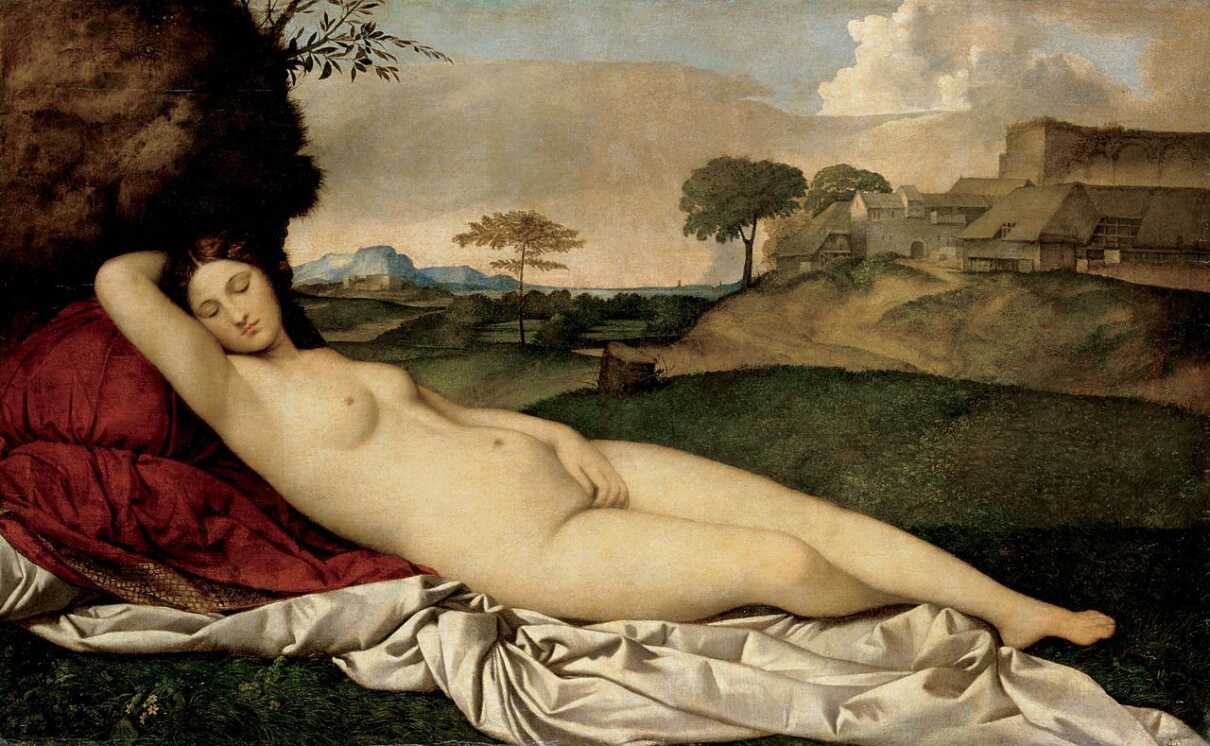
Charles-Andre Van Loo
Renaissance Nude Paintings
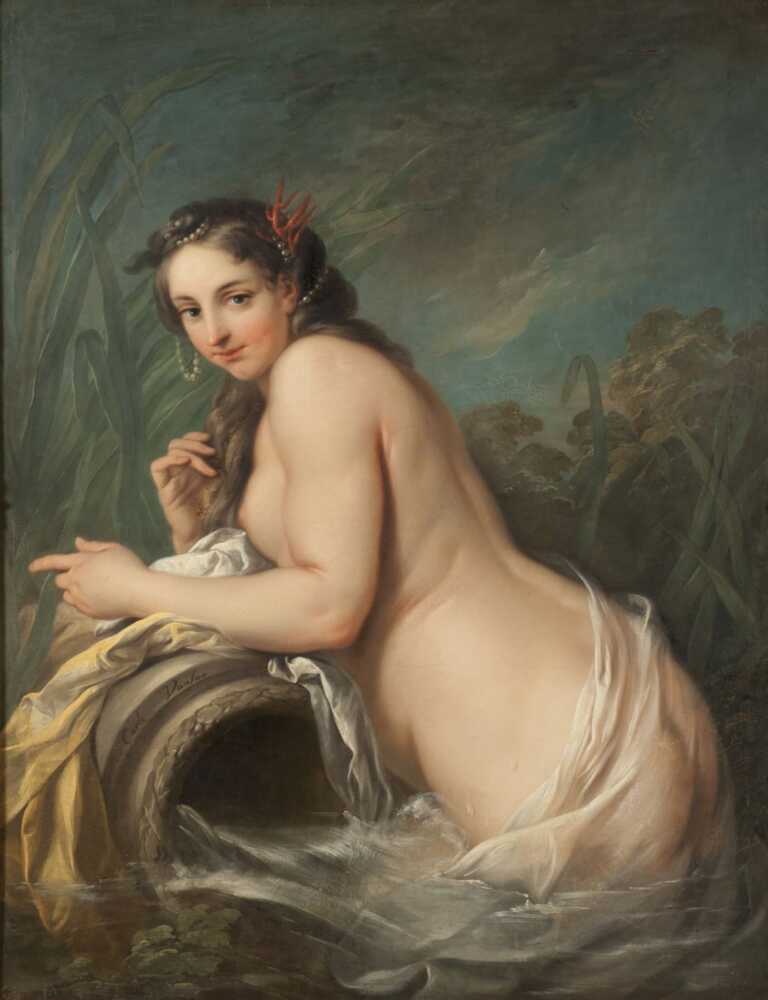
Van Loo Family
Descendant of a family of painters of Flemish origin, he trained with his father, the genre painter Jean-Baptiste van Loo, in his workshops in Turin and Rome.
He was also the nephew of Charles-André van Loo, and the brother of François van Loo, and Charles-Amédée-Philippe van Loo.
He traveled to Paris to complete his studies, entering the Royal Academy, where he obtained the Grand Prix de Rome in 1726, where he traveled with his brother François and his uncle Carle.
Before returning to France he made several portraits of different members of the Royal House in Turin.
In 1733 he returned to Paris, being admitted to the Royal Academy and to which he was appointed adjunct professor in the specialty of portraiture, in 1735.
Van Loo Art Painting Prints

Influences
At that time he was influenced by the portraits of him by the baroque painter Hyacinthe Rigaud, endowed with an ostentatious staging, with sumptuous details that generate a great impression of splendor.
On the death of Jean Ranc, Rigaud proposed Van Loo to the Spanish kings as official court portraitist, arriving in Madrid in 1737, where he was able to portray members of the Spanish royal family.
All these portraits, according to the French aesthetic, he placed in royal rooms, surrounded by columns and rich curtains and tapestries, as well as other symbols and luxurious details, which were applauded by the Family and the Court and the artistic committees of the Crown. .
Charles-Andre Van Loo Nude painting
Allegorical Portrait Of A Lady As Diana Wounded By Cupid
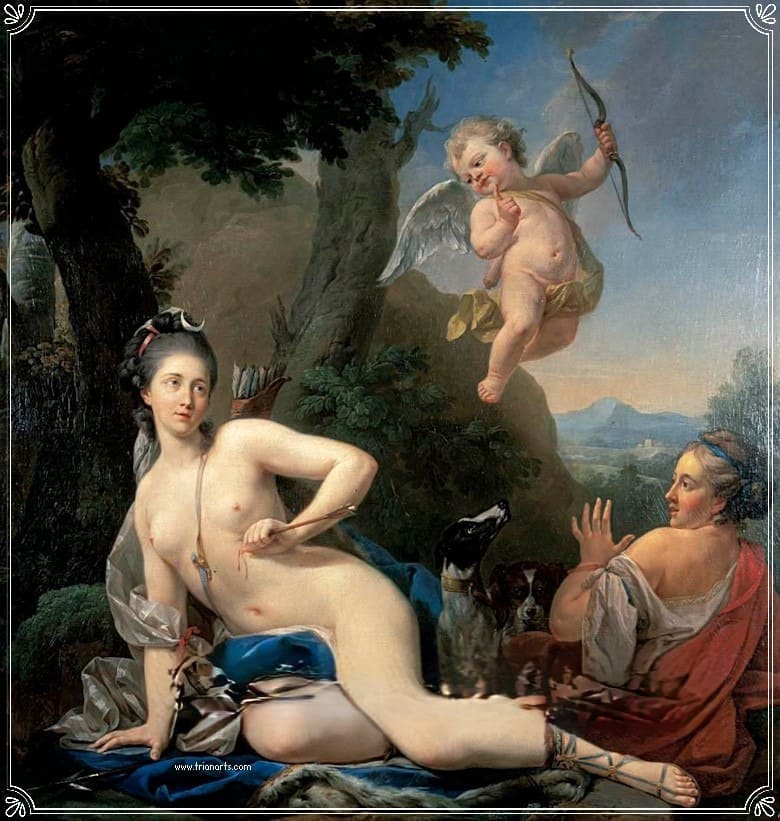
Monumental Portraits
Among all these portraits, the monumental group portrait that houses the Prado Museum stands out, of the family of Felipe V, in which the king appears surrounded by his children, among whom are the future kings Fernando VI and Carlos III , and his second wife, Isabel de Farnesio, whose drawing is kept at the San Fernando Academy of Fine Arts and his sketch at the Musée du Château de Versalles.
In 1744 he was named the first chamber painter and director of the Preparatory Board, an assembly that prepared admission to the Academy of San Fernando, founded in 1752, in which he assumed the position of director of painting.
Mythological Themes and Nude Artworks by Van Loo
Van Loo made some mythological-themed works, among them, “Education of Cupid by Venus and Mercury”, currently in the Royal Academy of Fine Arts of San Fernando in Madrid, the place for which the painting was commissioned to decorate what would be said. institution.
Likewise, he carried out some genre painting scenes, inspired by the style of Dutch painters, such as David Teniers II, on cardboard, as designs for tapestries, destined for the Royal Factory of Santa Bárbara throughout the 1740s.
First painter of King Felipe VI
In 1746, upon his arrival on the throne, Felipe VI named him the King’s First Painter, painting official portraits of the monarch and his wife, Barbara of Braganza.
In 1752 he returned to France, where after the death of his uncle Carle, he assumed the post of director of the École Royale des Élèves Protégés, (Royal School of Protected Students) that prepared the winners of the Rome Prize, before traveling to Italy.
He presented works at the Paris Salon, from 1753 to 1769, achieving applause for his work on all occasions. He worked at the court of Versailles, painting members of the royal family, including the future Louis XVI. He died in Paris on March 20, 1771.
Van Loo Art Painting Prints

Charles-Andre van Loo Nude Painting – Nude Artwork in Renaissance
Mars and Venus – Museum of Fine Arts Houston TX USA
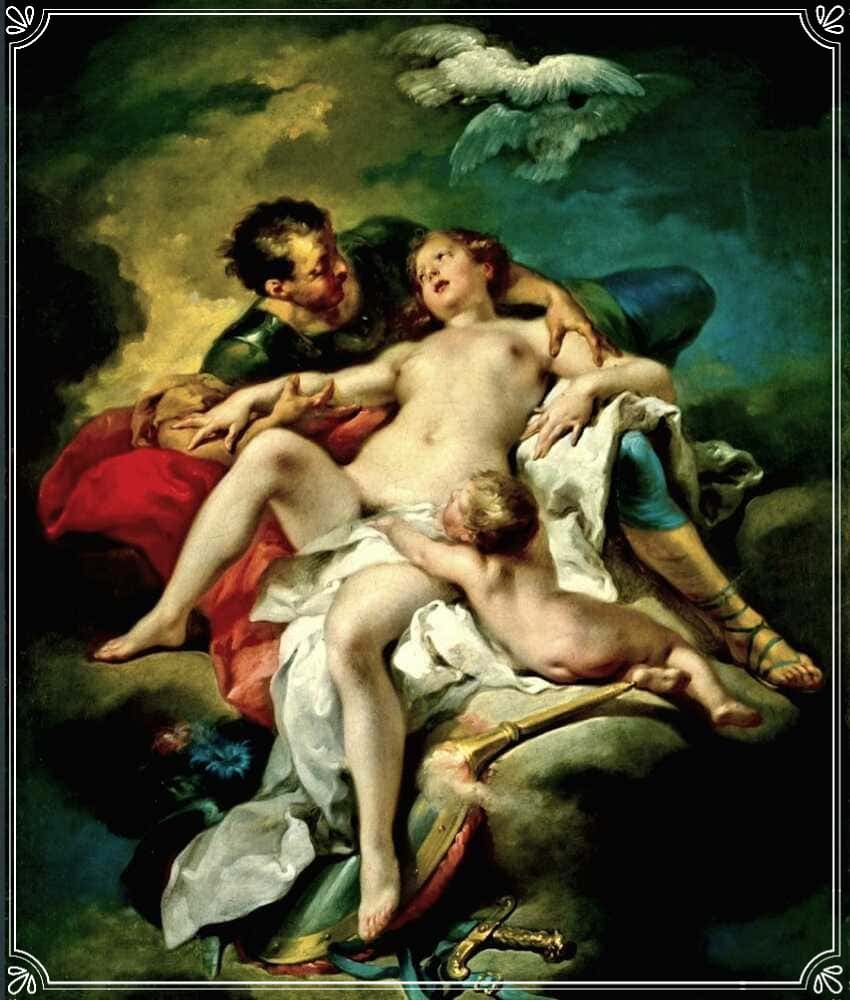
Mars and Venus
Charles-Andre van Loo (Carle van Loo)
Style: Rococo
Genre: mythological painting
Media: oil, canvas
Location: Museum of Fine Arts Houston (MFAH), Houston, TX, US


.
Peter Paul Rubens: Venus, Cupid, Bacchus and Ceres
Baroque Nude Painting
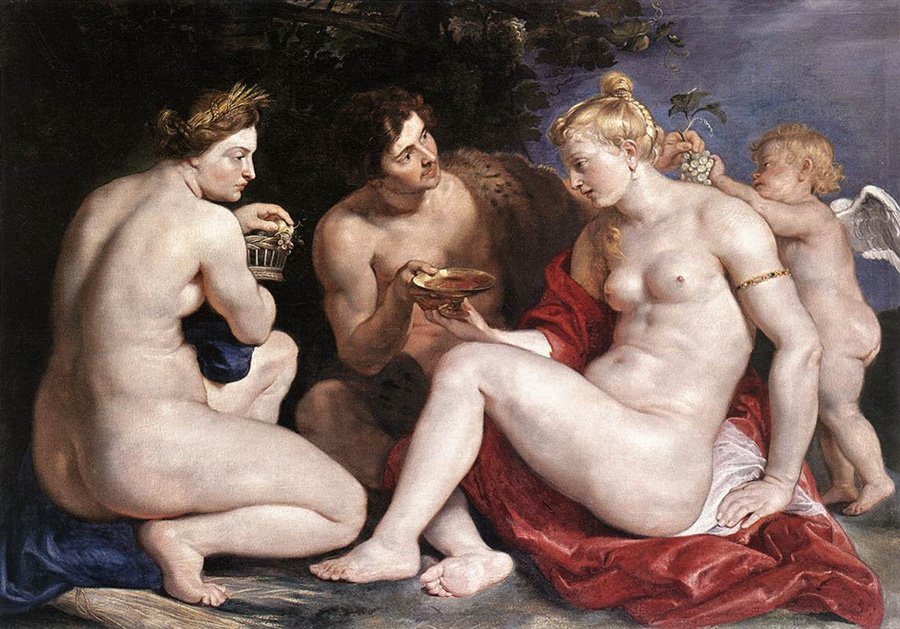
Correggio (Antonio Allegri) – Danae
Oil on canvas; 74 3/16 × 86 13/16 × 4 1/2 in. Galleria Borghese
Nude Painting
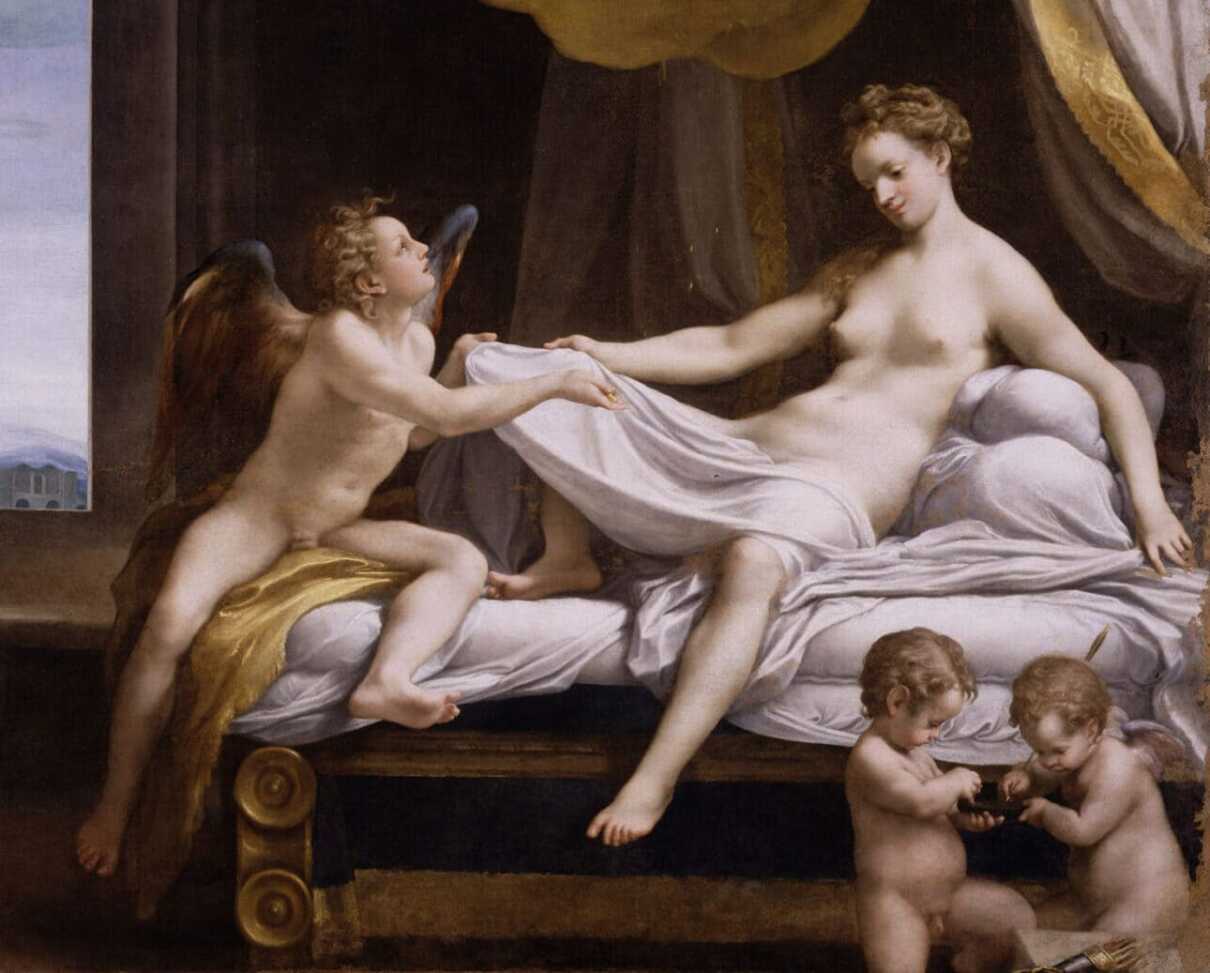
The Judgement of Paris
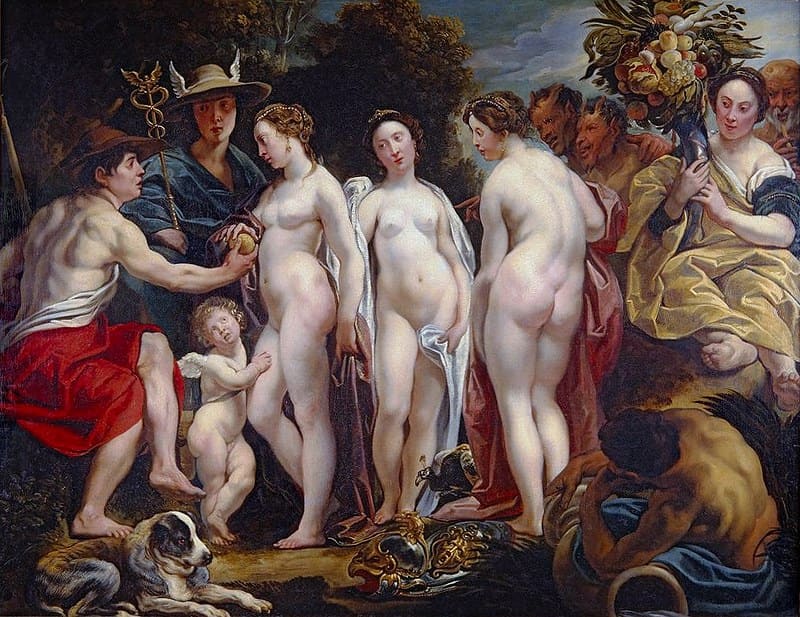
Jacob Jordaens (May 19, 1593 – October 18, 1678) was a Flemish painter, draftsman and tapestry designer known for his history paintings, genre scenes and portraits. After Peter Paul Rubens and Anthony van Dyck, he was the leading Flemish Baroque painter of his day. Unlike those contemporaries he never traveled abroad to study Italian painting, and his career is marked by an indifference to their intellectual and courtly aspirations.
In fact, except for a few short trips to locations elsewhere in the Low Countries, he remained in Antwerp his entire life. As well as being a successful painter, he was a prominent designer of tapestries.
Venus y Adonis
François Lemoyne (1688 -1737)
He was a French painter of the Rococo style, winner of the Prix de Rome and a participant in the decoration of the Palace of Versailles.
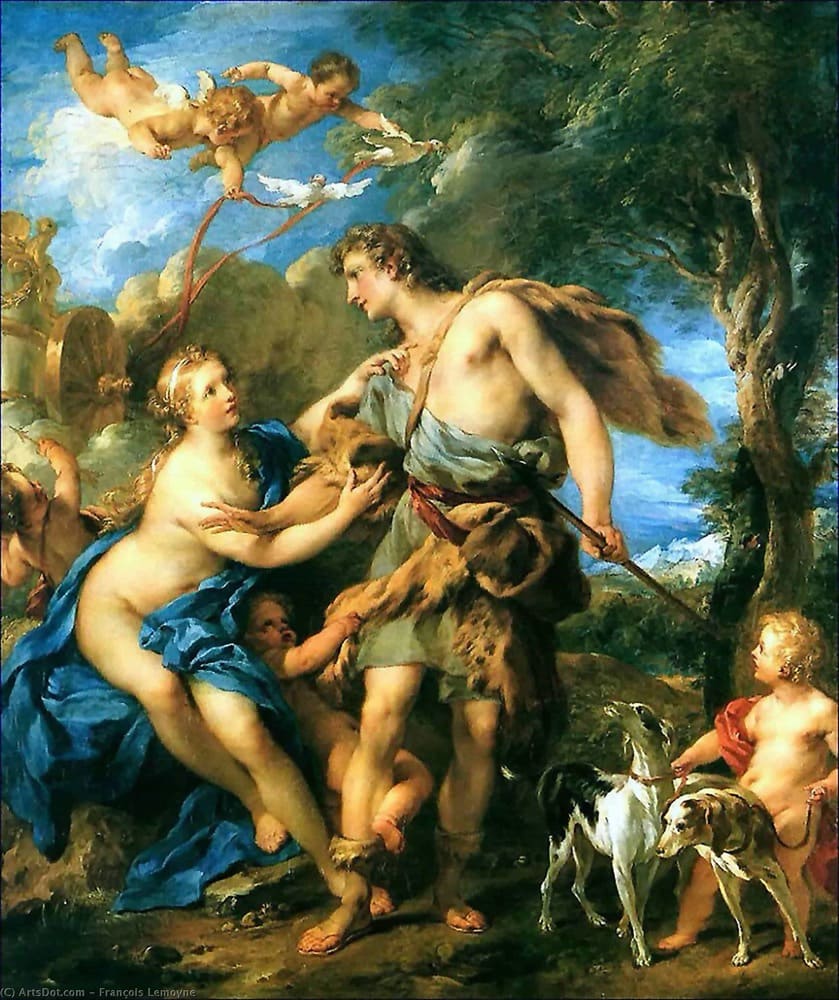
Although this work does not belong to the Renaissance, but to the Rococo, it is worth showing it, to see the transition between Renaissance and modern painting.
François Lemoyne, In 1701, at the age of 13, he entered the Royal Academy of Painting and Sculpture as a student. He studied there under Louis Galloche and remained there until 1713 despite being excluded from painting classes for insolence. Meanwhile, reinstated after an official apology, he won the Prix de Rome for painting in 1711 for Ruth Earned in the Fields of Boaz.
He was received as a member of the Royal Academy in 1718, with the presentation of the painting Hercules and Cacus that provoked a unanimous concert of praise.
He had as disciples at this time Charles-Joseph Natoire and François Boucher, the latter a great painter of Nudes.
ETSY Art Painting Prints

Eustache Le Sueur Nude Painting
French painter, one of the founders of the Académie royale de peinture et de sculpture in France. His style falls within the current of French classicism.
The Birth of Cupid
1645 – 1647 – Baroque style – mythological painting, oil, panel – Louvre Museum, Dimensions: 182 x 125 cm
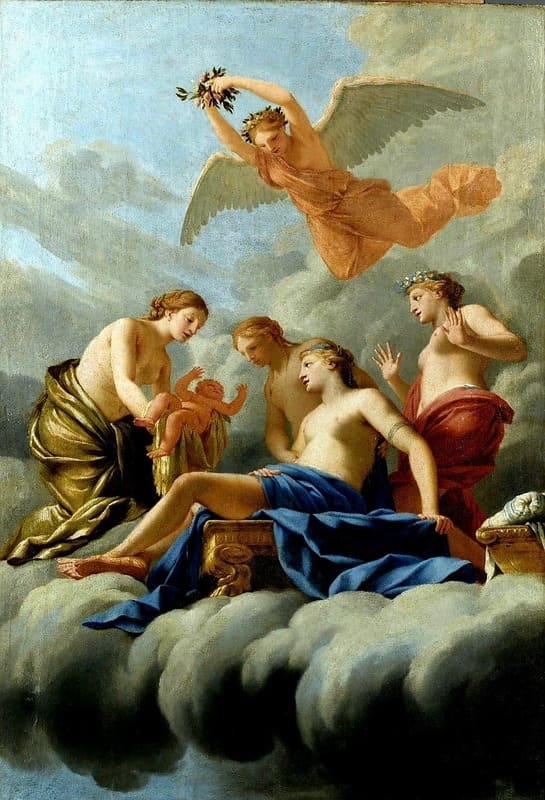
Born in Paris on November 19, 1616, Eustache Le Sueur was the son of a wood turner, Cathelin Le Sueur (1570-1666). He very quickly showed a gift for drawing and his father managed to get him into the studio of Simon Vouet (1590-1649), first painter to the king, in 1632, at the age of sixteen. The young artist spent ten years in this studio, the most famous in the capital. His fellow students would become prestigious painters: Charles Le Brun and Nicolas Poussin. Unlike his two classmates, Le Sueur did not make the trip to Italy, a dream of all artists of the time, but he discovered the art of the Italian Renaissance in the royal palaces and private collections in Paris.
Paint Hotel Lambert in Paris
This series marks a major stylistic evolution. While he can be broadly related to the Baroque during his youth, the style of Le Sueur style becomes more rigorous, his compositions more thoughtful. This evolution is also that of all French painting of the middle of the 17th century. Along with Charles Le Brun, Philippe de Champaigne and several other artists, Eustache Le Sueur was one of the founding members of the Royal Academy of Painting and Sculpture in 1648. He is now recognized as one of the major painters of grand style , historical painting. He received official orders and renovated the decoration of the apartment of Anne of Austria (1601-1666) and that of her son, the young Louis XIV (1638-1715), at the Louvre. He also works for private sponsors asking him to decorate their Parisian mansions. Thus, he painted the nine muses of Greek mythology for the Hotel Lambert, located on the Île Saint-Louis, belonging to the extremely wealthy Nicolas Lambert de Thorigny, president of the Chamber of Auditors.
.
Where are the biggest Renaissance festivals in the world?
Texas Renaissance Festival: The Texas Renaissance Festival is the world’s largest Renaissance Fair. Nearly 400,000 people attend yearly in Plantersville, Texas, on weekends through October and November and on Thanksgiving Day. Minnesota Renaissance Festival:That celebration has since relocated to Shakopee, MN and has grown to be the largest Renaissance Festival in the United States with an annual attendance of 300,000. Renaissance faire.
Tags
Nude art gallery, erotic nude paintings, naked baroque, classic nude paintings, The Nude in the Middle Ages and the Renaissance.
Nudists art, nudity painting, nude in paint, nude painters, nudity in painting, Renaissance Nudists art, Renaissance nudity painting, nude in paint, Renaissance nude painters, nudity in painting.
Classical nudes, classical nude, paintings of naked women, painting naked, naked painting, history of nudes, history nude, nude history, nudes in history, history nudes, nude in history, history of nude, history of the nude, historic nudes, renaissance nudes, history of nude Painting.
Renaissance nude painters List
- Rubens
- Da Vinci
- Titian
- Tintoretto
- Giorgione
- Botticelli
- Van Loo
- Correggio
- Jacob Jordaens
- Lemoyne.
- Le Sueur





